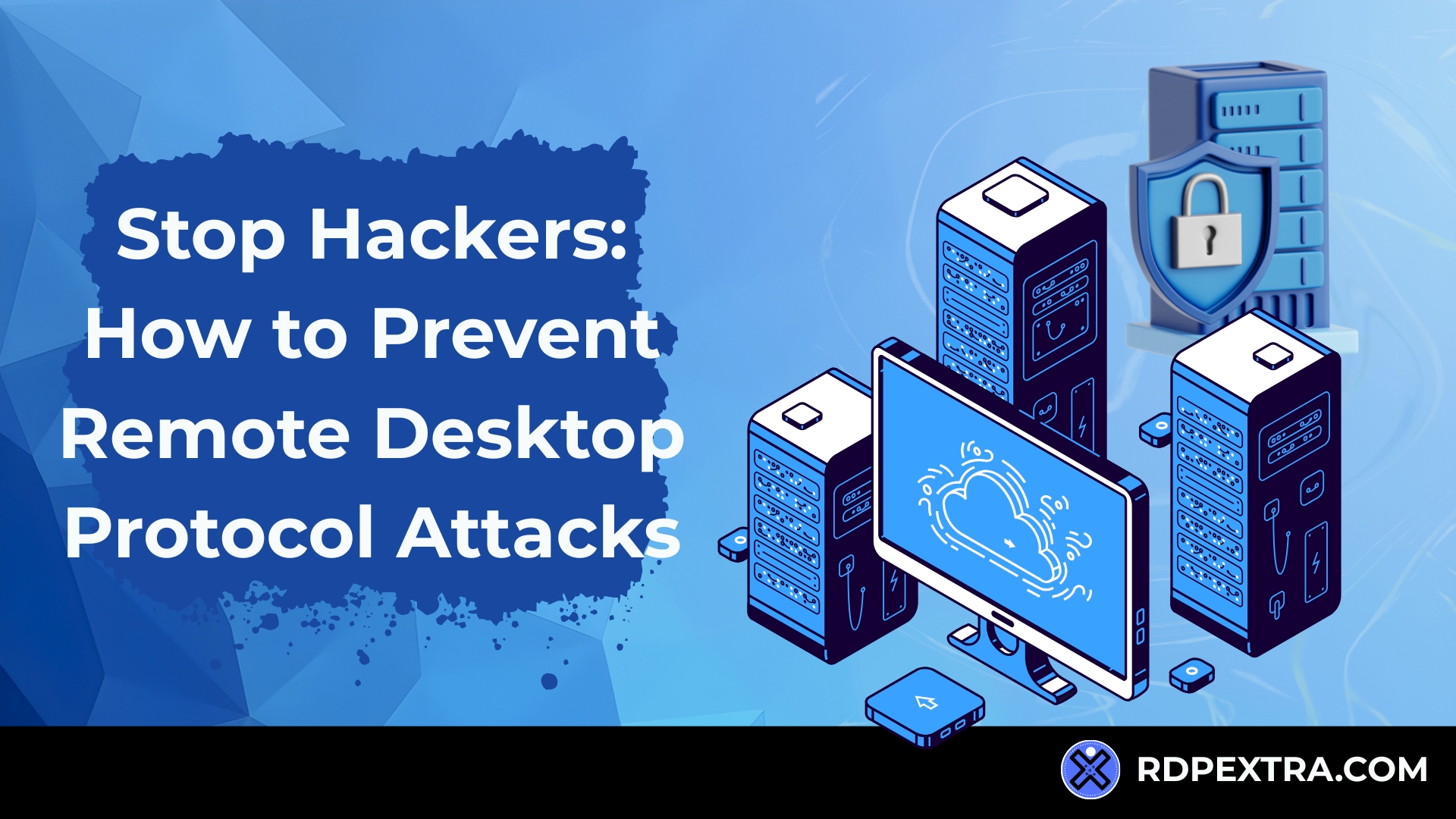
Stop Hackers at the Door: Proven Ways to Prevent RDP Attacks in 2025
Remote work is the new normal, and the Remote Desktop Protocol (RDP) has become a lifeline for businesses, freelancers, and remote employees. With the click of a mouse, you can access your office computer or cloud server from anywhere. Sounds convenient, right? But convenience often comes with risk. In 2025, RDP attacks are more sophisticated, with cybercriminals constantly finding new ways to exploit the remote desktop protocol port 3389. Many of these attacks rely on remote desktop brute force techniques that can compromise even seemingly secure accounts tcp port 3389.
Imagine leaving your front door wide open in a busy city—RDP without proper security is just like that. This blog will guide you through the most effective strategies to prevent RDP attacks, secure tcp port 3389, and maintain robust remote desktop protocol security for your business or personal systems.
Understanding RDP and Its Vulnerabilities
What is Remote Desktop Protocol?
Remote Desktop Protocol is a Microsoft-developed technology that allows users to connect to a computer remotely, as if they were sitting right in front of it. It sends screen visuals, keyboard input, and mouse commands across networks. While this makes remote work seamless, it also exposes your systems to potential threats if not secured properly.
Why it matters: Every open RDP session is essentially a gateway to your system. Without proper defenses, attackers can exploit it to access sensitive data, deploy malware, or even take control of your network.
Why Remote Desktop Protocol Port 3389 Is a Hacker Magnet
By default, RDP uses tcp port 3389. Attackers know this, making it a prime target for scanning and attacks. Opening the Remote Desktop Protocol port 3389 on the internet is like putting a neon sign saying, “Hack Me Here!” Cybercriminals often use automated tools to identify this port and initiate remote desktop brute force attacks, trying thousands of username-password combinations in minutes.
Key takeaway: Never leave tcp port 3389 exposed without additional security layers.
Common RDP Attack Types
- Brute Force Attacks: Automated scripts try multiple password combinations until one succeeds.
- Ransomware Deployment: Once an attacker gains access via RDP, they can encrypt your files and demand ransom.
- Credential Theft: Hackers can extract login information from compromised systems, potentially affecting other accounts.
- Session Hijacking: Cybercriminals can take over an active RDP session and operate under legitimate credentials.
These attack types underline why remote desktop protocol security must be a top priority for any organization or individual using RDP.
Signs Your RDP Is Under Attack
Even if you have basic security in place, it’s crucial to monitor your system for warning signs. Recognizing early indicators can prevent serious breaches:
- Unusual Login Attempts: Repeated failed login attempts from unknown IPs often indicate a brute force attack.
- Account Lockouts: Frequent lockouts of administrator accounts may signal hacking attempts.
- Suspicious Activity in Logs: Security logs showing repeated connections to tcp port 3389 from unknown sources are a red flag.
- Unexpected Changes: Modifications to group policies or security settings could indicate compromised access.
By proactively monitoring for these signs, you can respond before attackers gain full access.
Best Practices to Prevent RDP Attacks
Securing RDP is not just about patching software—it’s about layered defense. Here’s a detailed guide:
1. Change Default TCP Port 3389
Attackers assume RDP runs on tcp port 3389. Changing this to a custom port adds a layer of obscurity, reducing exposure to automated attacks. While not a complete solution, it lowers the likelihood of random scans targeting your server.
2. Use Strong, Unique Passwords
Weak passwords are the easiest entry point for hackers. Enforce passwords that combine uppercase, lowercase, numbers, and symbols. Avoid predictable patterns like “Password123!” or reused credentials across multiple accounts.
Pro tip: Use a password manager to generate and store complex passwords.
3. Enable Multi-Factor Authentication (MFA)
Adding MFA ensures that even if attackers crack a password, they cannot log in without the second authentication factor, such as an authenticator app or SMS code. MFA is one of the most effective defenses against remote desktop brute force attacks.
4. Limit IP Addresses That Can Access RDP
Whitelist trusted IP addresses and block all others. By limiting access to specific networks, you significantly reduce the attack surface of your remote desktop protocol port 3389.
5. Use VPN or Jump Servers
Instead of exposing RDP directly to the internet, require connections through a secure VPN or jump server. This ensures only authenticated users can reach your RDP service and reduces the chance of external attacks.
6. Keep Systems Updated
Cybercriminals exploit outdated systems. Regularly patch Windows and RDP clients to fix vulnerabilities. This simple step can prevent many remote desktop protocol security issues before they become critical.
7. Educate Users
Human error is a top factor in security breaches. Train users on the risks of phishing attacks, password reuse, and unsafe RDP practices. Even the best technical defenses fail if users compromise credentials.
Advanced Security Measures
For organizations that require maximum protection, advanced strategies can further mitigate risk.
1. Implement RDP Gateways
An RDP gateway acts as a secure intermediary, controlling access to internal systems and adding an extra layer of authentication.
2. Monitor for Remote Desktop Brute Force Attempts
Use SIEM (Security Information and Event Management) tools to detect unusual login patterns. Automated alerts help you respond quickly to attempted breaches.
3. Logging and Real-Time Alerts
Enable logging for RDP connections and configure alerts for repeated login failures or traffic spikes on tcp port 3389. Timely alerts can prevent attackers from persisting unnoticed.
4. Threat Intelligence and AI-based Detection
Modern cybersecurity platforms leverage AI to identify anomalies in login behavior and network traffic. Combining AI insights with remote desktop protocol security practices ensures early detection of attacks.
RDP Attack Prevention Table
| Security Measure | Description | Effectiveness | Complexity |
| Change the default TCP port 3389 | Use a custom port for RDP instead of 3389 | Medium | Low |
| Strong Passwords | Use complex, unique passwords | High | Low |
| Multi-Factor Authentication (MFA) | Add a second verification layer | Very High | Medium |
| IP Whitelisting | Allow only trusted IPs | High | Medium |
| VPN / Jump Servers | Route all RDP traffic through a secure network | Very High | Medium |
| Regular Updates | Patch Windows and RDP clients | High | Low |
| User Education | Train users on phishing and secure practices | Medium | Low |
| RDP Gateway | Add a secure entry point with controlled access | Very High | High |
| SIEM Monitoring | Detect remote desktop brute force attempts in real time | Very High | Medium |
| AI Threat Detection | Use AI for anomaly detection in RDP behavior | Very High | High |
This table simplifies RDP security measures, allowing administrators to prioritize actions based on effectiveness and complexity.
Conclusion
RDP is an essential tool for remote work, but it comes with inherent risks if left unsecured. By implementing layered defenses—changing the default tcp port 3389, enforcing strong passwords, enabling MFA, limiting IP access, using VPNs, monitoring for remote desktop brute force attacks, and leveraging advanced security tools—you can dramatically reduce exposure to attacks in 2025 and beyond.Call-to-Action: Don’t leave your network vulnerable. Download our RDP Security Checklist and take control of your remote desktop protocol security today.
FAQ
The default remote desktop protocol port 3389 is commonly targeted by hackers for brute force attacks. Leaving it exposed can lead to unauthorized access. Changing the port and using additional security measures significantly reduces risk
Use strong, unique passwords, enable multi-factor authentication (MFA), limit IP access, and monitor login attempts. These steps protect your system against remote desktop brute force attacks on tcp port 3389.
Exposing RDP directly online is risky. Always use a VPN or jump server to securely access your remote desktop protocol port 3389, ensuring only authorized users can connect.
Watch for multiple failed login attempts, sudden account lockouts, and unusual activity on tcp port 3389. Monitoring logs and alerts helps detect early remote desktop protocol security threats.
Implementing RDP gateways, using SIEM tools for monitoring, and AI-based anomaly detection enhances remote desktop protocol security, protecting against brute force attacks and unauthorized access.

Leave a Reply